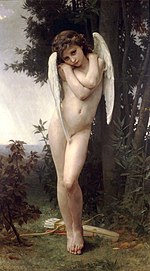Cupid: Difference between revisions
| Line 50: | Line 50: | ||
* [[Roman mythology]] |
* [[Roman mythology]] |
||
* [[Love dart]]s as used by snails |
* [[Love dart]]s as used by snails |
||
i love reneee |
|||
==References== |
==References== |
||
Revision as of 20:17, 16 September 2009
This article needs additional citations for verification. (October 2008) |

In Roman mythology, Cupid (Latin cupido) is the god of erotic love and beauty. He is also known by another one of his Latin names, Amor (cognate with Kama). He is the son of goddess Venus.
In popular culture Cupid is frequently shown shooting his bow to inspire romantic love, often as an icon of Valentine's Day.
For the equivalent deity in Greek mythology, see Eros.
Legend
In the Roman version, Cupid was the son of Venus (goddess of love) and Mars (god of war). In the Greek version he was named Eros and seen as one of the primordial gods (though other myths exist as well). Cupid was often depicted with wings, a bow, and a quiver of arrows. The following story is almost identical in both cultures; the most familiar version is found in Lucius Apuleius's Metamorphoses. When Cupid's mother Venus became jealous of the princess Psyche, who was so beloved by her subjects that they forgot to worship Venus, she ordered Cupid to make Psyche fall in love with the vilest thing in the world. When Cupid saw Psyche, however, he was so overcome by her beauty that he fell in love with her himself.
Following that, Cupid visited Psyche every night while she slept. Speaking to her so that she could not see him, he told her never to try to see him. Psyche, though, incited by her two older sisters who told her Cupid was a monster, tried to look at him and angered Cupid. When he left, she looked all over the known world for him until at last the leader of the gods, Jupiter, gave Psyche the gift of immortality so that she could be with him. Together they had a daughter, Voluptas, or Hedone, (meaning pleasure) and Psyche became a goddess. Her name "Psyche" means "soul."
Cult
Cupid's cult was closely associated with that of Venus, with Cupid being worshiped as devotedly as she. Additionally, Cupid's power was supposed to be even greater than his mother's, since he had dominion over the dead in Hades, the creatures of the sea and the gods in Olympus. Some of the cults of Cupid suggested Cupid as son of Night and Hell mated with Chaos to produce both men and gods, making the gods the offspring of love.
Portrayal in art and literature

In painting and sculpture, Cupid is often portrayed as a nude (or sometimes diapered) winged boy or baby armed with a bow and a quiver of arrows.
The Hindu Kāma also has a very similar description. On gems and other surviving pieces, he is usually shown amusing himself with childhood play, sometimes driving a hoop, throwing darts, catching a butterfly, or flirting with a nymph. He is often depicted with his mother (in graphic arts, this is nearly always Venus), playing a horn. In other images, his mother is depicted scolding or even spanking him due to his mischievous nature. He is also shown wearing a helmet and carrying a buckler, perhaps in reference to Virgil's Omnia vincit amor or as political satire on wars for love or love as war.
Cupid figures prominently in ariel poetry, lyrics and, of course, elegiac love and metamorphic poetry. In epic poetry, he is less often invoked, but he does appear in Virgil's Aeneid changed into the shape of Ascanius inspiring Dido's love. In later literature, Cupid is frequently invoked as fickle, playful, and perverse. He is often depicted as carrying two sets of arrows: one set gold-headed, which inspire love; and the other lead-headed, which inspire hatred.
The best-known story involving Cupid is the tale of Cupid and Psyche.
In the Artemis Fowl book series, the character Holly Short's great-great grandfather is Cupid.
Valentine's Day

Cupid has become a symbol for Valentine's Day.
The most common holiday representation of Cupid is a putto with wings, wearing a diaper, holding a bow and arrow. Sometimes the arrow will have a heart for its tip.
Modern reinterpretations of the Cupid character may leave off traditional details of the character, but the character's main purpose generally remains to help or make people fall in love or possibly engage in physical intimacy.
See also
- Aphrodite
- Apollo and Daphne
- Cherub
- Eros (love)
- Eros (mythology)
- Kama, the god of love in Hinduism.
- Love at first sight
- Putto
- Roman mythology
- Love darts as used by snails
i love reneee
References
- Cotterell, Arthur & Storm, Rachel (2008). The Ultimate Encyclopedia of Mythology. Annes Publishing Ltd.
{{cite book}}: CS1 maint: multiple names: authors list (link) - Arthur Cotterell & Rachel Storm, The Ultimate Encyclopedia of Mythology, 2008 Annes Publishing Ltd.
- Fabio Silva Vallejo, Mitos y leyendas del mundo (Spanish), 2004 Panamericana Editorial.

